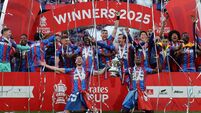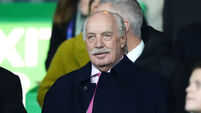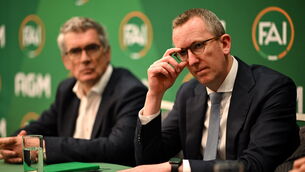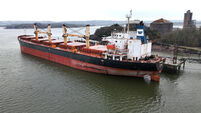Tommy Martin: Paul Gascoigne’s beauty and bedlam amid the FA Cup’s last great hurrah
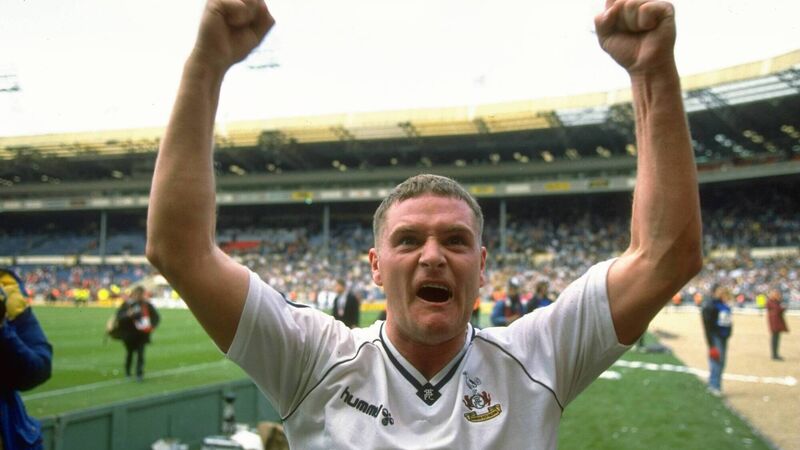
Paul Gascoigne of Tottenham Hotspur celebrates their win after the 1991 FA Cup semi-final against Arsenal at Wembley Stadium. Tottenham Hotspur won the match 3-1. Picture: Simon Bruty/Allsport
“Is Gascoigne going to have a crack? He is you know…Oh I say! Brilliant! That is Schoolboys' Own stuff!”
The FA Cup died, for me, from ’91 to ’93; sometime between Gazza’s goal and Sky TV.
It’s entirely personal, of course, but I’d date its last great hurrah back to that Saturday afternoon 30 years ago this week, when Tottenham beat Arsenal in the first cup semi-final to be played at Wembley and Barry Davies wondered if Gascoigne was going to have a crack. Shake that game out and it’s like an old coat full of mementoes and harbingers from the days before football changed forever.
If it is news to many of you that FA Cup semi-final weekend is upon us again, then things were very different back in 1991. Just like today, the semi-finals of the FA Cup shared the first two weekends of April with the Grand National and the US Masters — two of the three on one weekend, the other completing the holy trinity of springtime sport.
That the cup semi-finals have become an afterthought would have been hard to believe for anyone watching Gascoigne line up that free-kick, four minutes into Tottenham’s famous 3-1 victory. This was the biggest game of the season and Gazza’s goal a moment of intense, super-charged energy unimaginable now outside of major international tournaments or big club finals.
The semi-final being played at Wembley in the first place was a big enough story. Usually roomy provincial grounds like Villa Park, Hillsborough, or Old Trafford provided the venue for cup semi-finals. On the occasions when a London ground was needed, it was either Arsenal’s Highbury or Tottenham’s White Hart Lane — neither an option this time.
Despite the logic of using Wembley, the decision provoked a very British debate. Some felt staging the semi-final on the hallowed turf would dilute the final’s mystique, the sense of Wembley as the Elysian Fields at the end of cup’s mudbound conflict. Maybe they were right.
It was the still-raw memory of another FA Cup semi-final day that swung the argument. “Common sense prevailed,” Arsenal manager George Graham later wrote. “After Hillsborough, staging the tie at Wembley was the only acceptable solution.” Two years after the disaster, the prospect of a too-big crowd in a too-small ground still haunted football.
Watch the pictures of the Tottenham and Arsenal teams making the long walk onto the Wembley turf and you feel a strange, anachronistic electricity, like the way a long-dead star still shines billions of light years away. There is a scruffiness and disorder to it, banners and balloons aloft, an unruly bedlam from the stands unrecognisable in all-seated, corporate box modernity.
The players wave enthusiastically to the crowd, as if spotting 77,000 family members. There is a delay when Gary Lineker — now a smooth, likeable TV presenter, then a smooth, likeable Tottenham centre-forward — realises the ball is flat. A pump is sourced from the Spurs kitman. Barry Davies fills, informing us that the game is being broadcast in 30 — 30! — countries.
“A contest of pride, and not a little prejudice,” Davies says. The sense of occasion is partly to do with the derby aspect, the fact that Arsenal were going for a then-still-sacred league and cup double, and that Tottenham’s finances were in the toilet.
But it was bigger than that. It was FA Cup semi-final weekend. Two live matches on BBC. First this, then EastEnders, then Nottingham Forest against West Ham (“Those other Eastenders” — Des Lynam). A year previously two glorious semi-finals unfolded on a sun-drenched spring Sunday, Crystal Palace beating Liverpool 4-3, Manchester United and Oldham — Oldham! — drawing 3-3, both after extra-time. Trust me, this was big.
But it was more than that, again. It was both the long afterglow of Italia ’90 and the beginning of football’s shift from hooligan-ridden embarrassment to mass-market cultural phenomenon. Ironically, if this FA Cup tie was a measure of football’s rocketing popularity, the logical conclusion of that trend would hasten the competition’s decline: ladies and gentlemen, the Premier League and the Champions League.
At the heart of it all was Gazza. Rushed back to fitness after a hernia operation, he is heavy and jowly and only lasted an hour. But what an hour. His pre-match demeanour and post-match celebrations, viewed now, are disturbingly manic. Then, he was a cartoon character. “I love that face!” says Lynam, when Gascoigne gurns to camera.
Gascoigne tells Ray Stubbs afterwards how he needed injections from the team doctor to be calmed down the night before the match. He was hurtling from the intense celebrity of the 1990 World Cup towards the self-destructive madness of the cup final against Forest a month later, when he committed two terrible fouls and wrecked his knee with the second.
Watching him in the semi-final, though, is to see the soul of Gazza. The match starts in a hail of late tackles; tight shorts and muscular thighs swing first-time clearances to and fro. Arsenal compress the pitch with their high offside line. The referee is busy keeping order. For a man famously in torment, in the middle of this, it is Gascoigne who is beauty and calm.
Amid the cannon fire his every touch is sublime, his passing gives shape to a formless match. The explosive carpe diem of the free-kick is what we remember, but his interchange with Paul Allen for the first of Lineker’s goals was him in his happy place, the world between the white lines making sense when demons lay without.
At the end Tottenham celebrate with utter abandon. Gazza charges towards the fans making exaggerated pint-drinking gestures. Lineker interrupts his polite post-match interview because the players are going back out to take another lap of honour. It is the most Tottenham thing ever.
In studio, Jimmy Hill praises the football Tottenham played. “It was an absolute pleasure to watch, at Wembley, by a British team…with one or two who didn’t come from here!”
Their manager Terry Venables appears strangely distracted during the match. He was, at that time, trying to save the club from administration by leading a takeover with Alan Sugar. Sugar would later make the satellite dishes for Sky. When the first TV deal for the new Premier League was up for grabs between Sky and ITV a few years later, Sugar, by then Tottenham chairman, was allegedly heard on a phone call by an ITV executive telling someone to “blow them out of the water.”
After the semi-final Gazza grabbed Venables in a celebratory scrum. “And look at Terry Venables, goodness me,” exclaimed Davies. “They were kids together, Venables and Gascoigne!”
A month later, Gascoigne watched Tottenham lift the cup in tears from his hospital bed. It was nine days before his 24th birthday.

